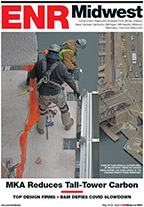At a seasonally adjusted annual rate of $444.9 billion, new construction starts in May retreated 16% from the previous month, it was reported by McGraw-Hill Construction, a division of The McGraw-Hill Cos. The decline followed substantial gains for total construction in March (up 23%) and April (up 11%), which reflected the lift coming from two massive nuclear power projects.
Without a similar lift in May, combined with a pullback for public works, the nonbuilding construction sector fell sharply. At the same time, nonresidential building in May showed improvement for the second month in a row, strengthening after weak activity in the early months of 2012, while residential building in May continued its moderate upward path. During the first five months of 2012, total construction starts on an unadjusted basis came in at $180.3 billion, up 6% from the same period a year ago.
The May statistics produced a reading of 94 for the Dodge Index (2000=100), down from 112 in April and 102 in March, but still 3% above the full year 2011 average of 92 for the Index. The April statistics included $8.5 billion for work on Units 2 and 3 at the Virgil C. Summer nuclear power facility near Jenkinsville, S.C., while the March statistics included $8.5 billion for work on Units 3 and 4 at the Vogtle nuclear power facility near Waynesboro, Ga.
In each case, the construction start entries were closely preceded by approval of a combined construction and operating license by the U.S. Nuclear Regulatory Commission, which enabled work to begin on the two nuclear reactors at each facility. If the entries for the Vogtle and Summer projects are excluded from March and April, then the pattern for total construction starts would be the following – March, down 3%; April, up 14%; and May, up 4%.
“Excluding the lift coming from this year’s nuclear power projects, the pattern for construction starts shows a loss of momentum through March, followed by strengthening activity in April and May,” stated Robert A. Murray, vice president of economic affairs for McGraw-Hill Construction. “The overall level of activity so far this year, without the nuclear power projects, is actually running slightly behind 2011, but at least the recent trend has been upward after a particularly weak start to 2012. The picture of a construction market that’s struggling to achieve upward momentum, with gains for some project types but losses for other project types, continues to hold true. Housing is edging upward, as earlier advances for multifamily housing are now being joined by gradual growth for single family housing,” Murray said.
“The commercial building sector has registered slight improvement from the extremely depressed amount back in 2010, but its upturn remains tenuous. On the down side, the institutional structure types and public works construction still face diminished funding from the federal, state and local levels of government,” he added.
Nonbuilding Construction
Nonbuilding construction in May dropped 47% to $132.1 billion (annual rate). A large share of the nonbuilding downturn was the result of a 71% plunge for the electric utility category, following its exceptionally strong volume in April, which reflected the start of work at the Summer nuclear facility in South Carolina. If the Summer project is excluded from the April statistics, then electric utility construction in May would be up 11%, while nonbuilding construction would be down a more moderate 9%.
The rate for electric utility construction in May was still relatively high, coming in just 8% below its average monthly pace during 2011. Support for the electric utility category in May came from the start of several large wind power projects – $803 million for phase 2 of a massive wind farm in California, $236 million for a wind farm in Hawaii and $210 million for a wind farm in Iowa. Other large electric utility projects in May included a $721-million gas-fired power plant in Louisiana, a $700-million power line project in Minnesota and South Dakota, and a $270-million solar power plant in Nevada.
The public works sector in May resumed its downward trend, retreating 16% after its brief upturn in April. Highway and bridge construction in May slipped 3%, with activity coming in 12% below the average monthly pace for these categories during 2011. The “miscellaneous” public works category, which includes mass transit, plunged 40% in May, after being lifted in April by an $877-million segment of the Eagle P3 commuter rail project in the Denver area.
Although down in May, the "miscellaneous" public works category did include the start of a $160-million light rail project in Oregon. The environmental public works categories showed decreased contracting in May, with sewers down 3%, river/harbor development down 23%, and water supply systems down 24%. The decline for water supply systems came despite the start of a $161-million water filtration facility in the state of Washington.



Post a comment to this article
Report Abusive Comment